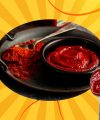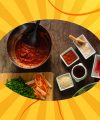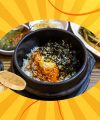Table Of Content
- Why This Guide Works?
- What Are The Essential Korean Pantry Items For An Indian Kitchen?
- 1. Gochujang Fermented Red Chili Paste
- 2. Gochugaru (Korean Chili Flakes)
- 3. Doenjang (Fermented Soybean Paste)
- 4. Soy Sauce (Ganjang)
- 5. Sesame Oil (Chamgireum)
- 6. Dried Kelp (Dashima) and Anchovies (Myeolchi)
- 7. Kimchi
- 8. Korean Rice (Short-Grain)
- Price Guide For Building A Korean Pantry In India
- Get Your Essential Korean Pantry Items For An Indian Kitchen Today!
I started Korean cooking in my cozy Kolkata kitchen nearly 3 years ago. I honestly thought it would be a tall order to recreate those mouthwatering flavors.
But I was so excited! I had seen in K-dramas and online food vlogs.
I made various Korean dishes, but mainly dishes like:
Additionally, I used to make a comforting bowl of bibimbap after office hours almost every day. I felt like they were just dreams. And I would require a trip to Seoul to really experience.
However, my culinary journey took a delightful turn when I began exploring Korean grocery stores.
I found them all over Kolkata, in Delhi, and Mumbai. Also, I found some ingredients by browsing online marketplaces.
To my surprise, I found that many essential Korean pantry staples were available right here in India.
Once I filled my kitchen with these ingredients, I realized I could now make Korean dishes right at home.
Also, I can tweak the spice levels and flavors to cater to my own Indian taste buds.
In this guide, I’ll share the must-have Korean pantry items. Trust me, I believe every Indian kitchen should stock these items.
So, if you’re eager to dive into authentic Korean cooking, this is the ultimate list!
Each item comes with a little backstory on its importance in Korean cuisine. Also, I have added tips on how to use it and where you can find it in India. Happy cooking!
Why This Guide Works?
I wanted to make sure this list wasn’t just another copy-paste from generic sites.
To ensure accuracy, I cross-checked items through trusted culinary references:
I follow Maangchi, one of the most respected authorities on Korean cooking.
She consistently emphasizes the role of gochujang, doenjang, and kimchi as the backbone of Korean cooking.
Additionally, I also follow food writers like Hooni Kim. She is the author of My Korea: Traditional Flavors, Modern Recipes.
I learned detailed explanations of why Korean staples are irreplaceable in building authentic flavor.
I also researched Zomato and Amazon India listings. They gave me the data on where these pantry staples can be sourced locally and at what price ranges.
So basically, I merged global authority with local sourcing and came up with this.
This guide is designed to help Indian cooks build a functional Korean pantry with confidence.
What Are The Essential Korean Pantry Items For An Indian Kitchen?
1. Gochujang Fermented Red Chili Paste

If there’s one ingredient you must buy first, it’s gochujang. It is a thick, sweet-spicy paste.
It is made of fermented chili, rice, and soybeans. Also, this is what gives Korean dishes their depth.
You can use it to make various Korean dishes, such as:
- Tteokbokki
- Bibimbap
- Kimchi stews
Additionally, you can use Gocgujang in marinades for meats.
Why it matters: According to Maangchi, gochujang provides “umami, heat, and sweetness all in one,” making it irreplaceable.
Where to find in India: Imported brands like CJ Haechandle and Chung Jung One are available at specialty stores in Delhi’s Lajpat Nagar.
Additionally, you can find it in Mumbai’s Korean markets in Khar and Andheri, and online on Amazon India and Seoul Store.
2. Gochugaru (Korean Chili Flakes)

Unlike Indian chili powder, gochugaru has a smoky-sweet profile and a medium level of heat.
Also, it’s the main seasoning for kimchi. You can also sprinkle it into soups. I add it to stir-fries and side dishes as well.
Why it matters: In My Korea, Hooni Kim explains that gochugaru is essential because it provides not just spice but also the “fruitiness” needed for authentic kimchi.
Where to find in India: Available in 100g to 500g packs through Amazon India, Korean marts in Gurgaon and Bangalore, and offline at INA Market in Delhi.
3. Doenjang (Fermented Soybean Paste)

Think of doenjang as Korea’s answer to Japanese miso but with a deeper, earthier taste.
Also, it’s the star of doenjang jjigae (soybean paste stew). Additionally, you can also add this to
- Soups
- Marinades
- Dipping sauces
Why it matters: According to The Korean Food Foundation, doenjang is rich in probiotics and minerals.
So, this makes it a nutritional powerhouse as well as a flavor base.
Where to find in India: Brands like Sempio and CJ are stocked at Delhi’s Lotte Mart.
Also, you can find these in Mumbai’s Korean grocery outlets and Seoul Store India.
4. Soy Sauce (Ganjang)

Korean soy sauce differs slightly from Chinese or Japanese varieties. You will find it to be lighter and saltier.
So, you can use this to make:
- Marinades
- Soups
- Stir-fried side dishes
Mostly, I use Ganjang to make stir-fry dishes like Japchae (glass noodles).
Why it matters: According to Hyosun Ro of Korean Bapsang, Korean soy sauce defines the salt balance in many dishes.
Also, you shouldn’t always substitute it with Indian dark soy.
Where to find in India: Sempio soy sauce is widely available both online and in Asian grocery stores. You can find it across Delhi, Mumbai, and Bangalore.
5. Sesame Oil (Chamgireum)

Korean sesame oil is nutty and fragrant. Usually, you can add it as a finishing touch to enhance flavor.
You can use it in bibimba. Additionally, you can also use sesame oil to make:
- Dipping sauces
- Marinades
- Vegetable side dishes
Why it matters: The Korean Food Promotion Institute highlights that sesame oil is a “finishing essence” in Korean cuisine, giving dishes a signature aroma.
Where to find in India: You can buy Kadoya sesame oil or Korean brands at online stores like Amazon India and at physical stores in Lajpat Nagar (Delhi) and Koregaon Park (Pune).
6. Dried Kelp (Dashima) and Anchovies (Myeolchi)

These two items form the backbone of Korean soup stocks. The best thing you can make is a simple broth.
You just have to add dried kelp and small anchovies. This is the base for jjigae (stews), soups, and noodle dishes.
Why it matters: Maangchi’s recipes repeatedly stress that without a kelp-anchovy broth, Korean soups lose their authentic taste.
Where to find in India: You can find both dashima and dried anchovies at specialty Korean markets in Mumbai (Khar, Andheri).
Additionally, you can buy them through online platforms like Seoul Store India.
7. Kimchi

If you are planning to build a Korean pantry, it is incomplete without kimchi.
Kimchi is the iconic cabbage side dish that you ferment. And wait! You don’t just eat it as a banchan.
Also, you can use it to cook other delicious Korean dishes, such as:
- Fried rice
- Pancakes
- Stew
Why it matters: The Korean Food Institute describes kimchi as both a staple food and a cultural symbol, with recognized health benefits due to probiotics.
Where to find in India: Freshly made kimchi is sold by Seoul Store, online sellers in Gurgaon and Bangalore, and in select gourmet supermarkets like Foodhall in Mumbai.
8. Korean Rice (Short-Grain)

Short-grain rice has a sticky texture that’s perfect for bibimbap. Also, you can use the same for kimbap and everyday meals.
Also, I have tried using the Indian basmati. But it won’t give the same consistency.
Why it matters: According to the Korea Tourism Organization, rice is the foundation of every Korean meal.
Then, you can pair with banchan and soup.
Where to find in India: Nishiki and Ottogi brands are stocked in gourmet stores and Korean marts.
Additionally, you can also order online via Amazon India.
Price Guide For Building A Korean Pantry In India
This is an approximately calculated price range you will need to stock up on your Korean pantry essentials for the Indian kitchen.
- Gochujang: ₹400–₹600 for a 500g tub
- Gochugaru: ₹500–₹1,000 depending on size
- Doenjang: ₹450–₹700
- Soy sauce: ₹250–₹500
- Sesame oil: ₹350–₹700
- Dried kelp and anchovies: ₹300–₹600 each pack
- Kimchi: ₹350–₹500 for 400g jar
- Korean rice: ₹800–₹1,200 for 5kg bag
Get Your Essential Korean Pantry Items For An Indian Kitchen Today!
So! Now you know that you can easily build a Korean pantry in an Indian kitchen. This is no longer difficult.
Whether you’re in Delhi, Mumbai, or Bangalore, you can source most essentials through
- Specialty stores
- Online platforms
You have to start with the big three: gochujang, gochugaru, and kimchi.
Then, gradually add doenjang, sesame oil, and soup bases like dashima and anchovies.
With these on hand, you’ll be able to cook authentic-tasting Korean meals right at home.
So, as someone who started with nothing more than instant ramen packets, I can tell you that the moment you add real gochujang and sesame oil to your kitchen, your Korean dishes will transform completely.












